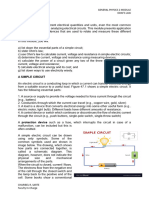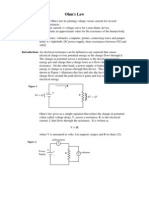Ohm's Law Lab
Ohm's Law Lab
Uploaded by
Eamon BarkhordarianCopyright:
Available Formats
Ohm's Law Lab
Ohm's Law Lab
Uploaded by
Eamon BarkhordarianCopyright
Available Formats
Share this document
Did you find this document useful?
Is this content inappropriate?
Copyright:
Available Formats
Ohm's Law Lab
Ohm's Law Lab
Uploaded by
Eamon BarkhordarianCopyright:
Available Formats
Eamon Barkhordarian Group Members: Asaf Rotman Malik Gill Shang Yip
3/4/2012 Period C APB Physics
Ohms Law Lab Purpose: To perform an experimental check of Ohm's Law by determining the relationship between current, voltage, and resistance. We also are doing this lab to practice constructing electric circuits and to understand voltmeters, ammeters, and real batteries/power supplies. Background: The first, and perhaps most important, relationship between current, voltage, and resistance is called Ohm's Law, discovered by Georg Simon Ohm and published in his 1827 paper, The Galvanic Circuit Investigated Mathematically. Ohm expressed his discovery in the form of a simple equation known as Ohms Law, which describes the relationship between the current flowing through resistance, R and the potential drop across it. Ohms Law states that voltage is directly proportional to the product of the current and the resistance. Voltage is quantitative expression of the electromotive force in charge between two points in an electrical field Current a flow of electric charge through a conductor (expressed in amps) Volts is the SI unit of electromotive force (expressed as V) Resistance is the opposition to the passage of an electric current through that element (expressed in Ohms ())
Below are the instrumentals we will be using for measurements: A voltmeter is an instrument for measuring electric potential in volts. An ammeter is an instrument for measuring electric current in amperes. Terminal Voltage is the sum of the individual battery cell voltages.
Methods: We did this experiment using the 0-12 setting for voltage. We take one wire connected to the power supply and bring the other end to the left side of the breadboard. We then took another wire and placed it in one of the holes within the same column as the previous wire connected. We took the other side of this new wire and brought it to next
Eamon Barkhordarian Group Members: Asaf Rotman Malik Gill Shang Yip
3/4/2012 Period C APB Physics
section of the breadboard. Taking the LED now, we connected it to the same row as the wire we had just placed, and brought the other side of the LED to the next section of the breadboard. Now we take the resistor and replicate what we have done with the LED light for the next section of the breadboard, making sure it is all on the same row. Finally, we have an outgoing wire that is connected to a multimeter to measure current and to check the amount of voltage supplied. We continued this experiment multiple times constantly changing the size of the resistor.
Eamon Barkhordarian Group Members: Asaf Rotman Malik Gill Shang Yip
3/4/2012 Period C APB Physics
Data: Voltage 3.7 5 8.1 9.9 10.4 3.1 6.4 8 10.3 10.5 4.7 6.2 7.6 7.9 9.6 10.6 5.1 5.5 6.6 6.9 9.3 11 Current (Amps) 0.0026 0.0034 0.0055 0.0067 0.0071 0.0021 0.0044 0.0054 0.007 0.0071 0.004 0.005 0.006 0.007 0.008 0.009 0.00132 0.00141 0.00171 0.00177 0.0028 0.0056 Resistance () 30 30 30 30 30 6,000 6,000 6,000 6,000 6,000 30,000 30,000 30,000 30,000 30,000 30,000 120 120 120 120 120 120
Eamon Barkhordarian Group Members: Asaf Rotman Malik Gill Shang Yip
3/4/2012 Period C APB Physics
Analysis and Conclusion: Once again, I chose to use a linear line of best fit and was right in choosing to do so. We have an r squared value of .9813 for the resistor strength of 30000 , an r squared value of .9997 for the resistor strength of 6000 , an r squared value of .9997 for the resistor strength of 30 , and an r squared value of .8674 for the resistor strength of 120 . All these r squared values are extremely close to 1. Because the r squared value was so close to one, it shows that the linear trend line is the best one to use. The relationship between voltage and current is linear. Since the slopes that I calculated are very small like 8.47 x 10 -4, it is not strongly linear. The voltage must increase by a lot to increase the current by a small amount. The inverse of the slopes are supposed to get the value of the resistor since the units of slope were Amps/V and the inverse was V/Amps. The equation for resistance in Ohms law is V/Amps so that verifies that the inverse of the slope is the resistance. But in my case the numbers seemed irrelevant. For example, for a resistor value of 30,000 Ohms, I would get an inverse slope of 1180. Since my numbers do not add up, I must say I have failed in proving the Ohms law equation in this lab. There must have been some mistakes made along the way. At one point, we had forgotten to use a resistor and blew out an LED light. Maybe one of our mistakes was that the wire was not connected to the breadboard firmly enough, not giving us an accurate reading. Another potential mistake could have been that we had not calculated the correct resistance. We might have not looked at the key correctly to multiply and add the values. This could have thrown our supposed resistance value off.
Once again the equation is , stating that V is proportional to current. In my lab I proved that that is true (as voltage increased, current also increased.) I also showed that as you increase the resistance, the current increases.
You might also like
- Student Exploration: Circuits: Vocabulary: Ammeter, Circuit, Current, Electron, Ohmmeter, Ohm's Law, Parallel CircuitDocument5 pagesStudent Exploration: Circuits: Vocabulary: Ammeter, Circuit, Current, Electron, Ohmmeter, Ohm's Law, Parallel CircuitGrayson Smith67% (3)
- Virtual Circuit Lab With AnswersDocument5 pagesVirtual Circuit Lab With AnswersPapaNoodle33% (3)
- Ohm's Law ReportDocument8 pagesOhm's Law ReportFelicia Paya FrancisNo ratings yet
- Unit 5Document7 pagesUnit 5NurFajrina MuthmainnahNo ratings yet
- Circuits SEDocument7 pagesCircuits SEmmguirg2No ratings yet
- Student Exploration: Circuits: Vocabulary: Ammeter, Circuit, Current, Electron, Ohmmeter, Ohm's Law, Parallel CircuitDocument11 pagesStudent Exploration: Circuits: Vocabulary: Ammeter, Circuit, Current, Electron, Ohmmeter, Ohm's Law, Parallel CircuitKoral Agan100% (1)
- Labs For Verification of Ohms Law Series and Parallel CircuitsDocument9 pagesLabs For Verification of Ohms Law Series and Parallel Circuitshuzaifaalisiddiqui270No ratings yet
- Lab1 - Manuel AbadieDocument6 pagesLab1 - Manuel AbadieManuel Abadie0% (1)
- Ohm's Law PHET ActivityDocument7 pagesOhm's Law PHET ActivityAtasha Adrienne GarciaNo ratings yet
- Ohm 22s Law Lab Report-2Document16 pagesOhm 22s Law Lab Report-2api-359167484No ratings yet
- Week 6 Lab - Basic MeasurementsDocument2 pagesWeek 6 Lab - Basic MeasurementsRowen PratherNo ratings yet
- Basic Circuit Laws: Georg Ohm Kirchhoff's LawsDocument4 pagesBasic Circuit Laws: Georg Ohm Kirchhoff's LawsrezhabloNo ratings yet
- Verify Ohm's LawDocument3 pagesVerify Ohm's Lawhammada10010% (2)
- Unit 5, Day 9: Ohm's Law: Objective QuestionDocument6 pagesUnit 5, Day 9: Ohm's Law: Objective QuestionTyler SmithNo ratings yet
- 17C ResistanceAndOhmsLawAnswersDocument4 pages17C ResistanceAndOhmsLawAnswersfxr6vywb5pNo ratings yet
- Experimental Analysis of V-I-R Relationships Using Ohm's Law in Ohmic and Non-Ohmic ConductorsDocument6 pagesExperimental Analysis of V-I-R Relationships Using Ohm's Law in Ohmic and Non-Ohmic ConductorsGill Wendell QuijanoNo ratings yet
- Physics Paper 1 - Required PracticalsDocument32 pagesPhysics Paper 1 - Required Practicalshmykw9x62rNo ratings yet
- Lab Report 2Document4 pagesLab Report 2Jeffrey RoeNo ratings yet
- EX4 Ohms LawDocument8 pagesEX4 Ohms LawRacquel Soliven100% (1)
- Physics Lab ReportDocument4 pagesPhysics Lab ReportNadine SjahsamNo ratings yet
- CBSE Class 10 Science Lab Manual - Ohms LawDocument7 pagesCBSE Class 10 Science Lab Manual - Ohms LawSyed MimunNo ratings yet
- Electrical ResistorsDocument14 pagesElectrical Resistorspratik gautamNo ratings yet
- Verify Ohms LawDocument3 pagesVerify Ohms Lawhome143No ratings yet
- Lab Answers p1Document10 pagesLab Answers p1api-343575651No ratings yet
- Physics Lab ReportDocument9 pagesPhysics Lab Reportapi-327729914No ratings yet
- OHMs LAWDocument6 pagesOHMs LAW23-st-037No ratings yet
- Electromagnetism Assignment #1 CircuitsDocument6 pagesElectromagnetism Assignment #1 CircuitsJanaarthNo ratings yet
- Ohms Law Lab ReportDocument5 pagesOhms Law Lab ReportI Anonymous100% (6)
- Group #3: Presented To: Presented byDocument27 pagesGroup #3: Presented To: Presented bywaleed azamNo ratings yet
- Electrical Circuit Lab1Document44 pagesElectrical Circuit Lab1rahmahamjad90No ratings yet
- Physics Exp 8 GRP 10Document6 pagesPhysics Exp 8 GRP 10Elizabeth Jade ViceraNo ratings yet
- Lab Report No: Physics Ac-Dc ElectronicsDocument17 pagesLab Report No: Physics Ac-Dc ElectronicsSalmanNo ratings yet
- EC1A Exp 4Document8 pagesEC1A Exp 4ernie5000No ratings yet
- Circuits SeDocument4 pagesCircuits Sewahbaabdelrahman7No ratings yet
- Ohms-Law WattDocument31 pagesOhms-Law WattCatherineNo ratings yet
- Ali Imran (FA17-BCS-047) A03Document6 pagesAli Imran (FA17-BCS-047) A03Ali ImranNo ratings yet
- OHMs LawDocument5 pagesOHMs Lawsantiagorachel445No ratings yet
- Currrent Electricity FinalDocument62 pagesCurrrent Electricity Finalchillspace.comNo ratings yet
- College Physics II Lab 6: Ohm's LawDocument9 pagesCollege Physics II Lab 6: Ohm's Lawapi-569816669No ratings yet
- Chapter 17 LabDocument3 pagesChapter 17 LabOMGPIKAJEWNo ratings yet
- Ohm's LawDocument6 pagesOhm's Lawعلي سالم الكوتNo ratings yet
- Ohms LawDocument8 pagesOhms Lawriyo wayneNo ratings yet
- Year 9 Science CAT Lab ReportDocument5 pagesYear 9 Science CAT Lab ReportKaitlyn CarrNo ratings yet
- Document 43Document20 pagesDocument 43bumbadiyaviralNo ratings yet
- Report On Electrical MeasurementsDocument14 pagesReport On Electrical MeasurementsNeeraj100% (1)
- Ohms LawDocument2 pagesOhms LawMurad M. Murad100% (1)
- Lab 3 Breadboard and Ohms LawDocument6 pagesLab 3 Breadboard and Ohms LawRasul Amirov100% (1)
- Principles and Definition of Ohms LawDocument36 pagesPrinciples and Definition of Ohms LawIrfanNo ratings yet
- Ohms LawDocument15 pagesOhms Lawavea93b100% (1)
- Lab 20 Report Ohms LawnewDocument5 pagesLab 20 Report Ohms Lawnewapi-270816603No ratings yet
- Variables Factor DescriptionDocument6 pagesVariables Factor Descriptionapi-264844045No ratings yet
- BEEE Lab ManualDocument122 pagesBEEE Lab ManualVikram Kamboj75% (4)
- Advance Physics For Grade 10 STE StudentsDocument5 pagesAdvance Physics For Grade 10 STE StudentsJoshua AsuncionNo ratings yet
- E306 Report - Parallel and Series CircuitsDocument5 pagesE306 Report - Parallel and Series CircuitsAbdul Rahman Mariscal100% (1)
- Experiment 2 Charges and Ohm LawDocument12 pagesExperiment 2 Charges and Ohm Lawعلي محمودNo ratings yet
- Complete Electronics Self-Teaching Guide with ProjectsFrom EverandComplete Electronics Self-Teaching Guide with ProjectsRating: 3 out of 5 stars3/5 (2)
- Lab 3Document4 pagesLab 3nas4243No ratings yet
- Hamlet Vs Pride and PrejudiceDocument4 pagesHamlet Vs Pride and PrejudiceEamon BarkhordarianNo ratings yet
- Magnetic Field LabDocument5 pagesMagnetic Field LabEamon BarkhordarianNo ratings yet
- Rochester-Chapter 14: Eamon Barkhordarian Period E Blackburn English MastersDocument5 pagesRochester-Chapter 14: Eamon Barkhordarian Period E Blackburn English MastersEamon BarkhordarianNo ratings yet
- Jane Eyre Reading Log #1Document1 pageJane Eyre Reading Log #1Eamon BarkhordarianNo ratings yet
- Pride and Prejudice Reading Log #1Document2 pagesPride and Prejudice Reading Log #1Eamon BarkhordarianNo ratings yet
- SNP Basic Background InformationDocument6 pagesSNP Basic Background InformationEamon BarkhordarianNo ratings yet
- Top 200 Drugs in OrderDocument7 pagesTop 200 Drugs in OrderEamon BarkhordarianNo ratings yet
- PCR and Agarose Gel ElectrophoresisDocument5 pagesPCR and Agarose Gel ElectrophoresisEamon Barkhordarian100% (1)
- The Prestige-Film ReviewDocument1 pageThe Prestige-Film ReviewEamon BarkhordarianNo ratings yet
- The Traffic ProblemDocument5 pagesThe Traffic ProblemEamon BarkhordarianNo ratings yet
- Arthur Conan Doyle. The Adventures of Sherlock Holmes.Document201 pagesArthur Conan Doyle. The Adventures of Sherlock Holmes.PDFreeBooks.orgNo ratings yet
- Dust Bowl Pictures With DescriptionsDocument5 pagesDust Bowl Pictures With DescriptionsEamon BarkhordarianNo ratings yet
- Adventures of Huckleberry Finn by Mark TwainDocument190 pagesAdventures of Huckleberry Finn by Mark TwainChandan SahaNo ratings yet
- Current U.S Supreme Court JusticesDocument2 pagesCurrent U.S Supreme Court JusticesEamon BarkhordarianNo ratings yet
- Dust Bowl Scrapbook Project OutlineDocument11 pagesDust Bowl Scrapbook Project OutlineEamon BarkhordarianNo ratings yet
- DNA Technology and The Human Genome WorksheetDocument4 pagesDNA Technology and The Human Genome WorksheetEamon BarkhordarianNo ratings yet
- Transition Words For EssaysDocument2 pagesTransition Words For EssaysEamon BarkhordarianNo ratings yet
- Vocabulary 3Document1 pageVocabulary 3Eamon BarkhordarianNo ratings yet
- Relative PronounsDocument1 pageRelative PronounsEamon BarkhordarianNo ratings yet
- Transative and IntransitiveDocument1 pageTransative and IntransitiveEamon BarkhordarianNo ratings yet
- SubjectsDocument1 pageSubjectsEamon BarkhordarianNo ratings yet
- THe Dust Bowl Newspaper ArticleDocument6 pagesTHe Dust Bowl Newspaper ArticleEamon BarkhordarianNo ratings yet
- PronounDocument1 pagePronounEamon BarkhordarianNo ratings yet
- The Preposition: Recognize A When You See OneDocument3 pagesThe Preposition: Recognize A When You See OneEamon BarkhordarianNo ratings yet
- Main ClausesDocument1 pageMain ClausesEamon BarkhordarianNo ratings yet
- Service Manual: 1-1.5KVA ModelDocument29 pagesService Manual: 1-1.5KVA ModelBubai BhattacharyyaNo ratings yet
- LC1D25M7 DATASHEET ID en-IDDocument4 pagesLC1D25M7 DATASHEET ID en-IDDhiki KurniawanNo ratings yet
- DefrostDocument3 pagesDefrostMarcial Jr. MilitanteNo ratings yet
- Turbocor Compressor Technology For Liquid Chiller Applications (PDFDrive)Document28 pagesTurbocor Compressor Technology For Liquid Chiller Applications (PDFDrive)Jim JonesjrNo ratings yet
- Deccan College of Engineering & Technology: Power Electronics Laboratory ManualDocument73 pagesDeccan College of Engineering & Technology: Power Electronics Laboratory ManualharshNo ratings yet
- Datasheet Spsa-V01Document11 pagesDatasheet Spsa-V01Nguyễn CôngNo ratings yet
- Buoyancy and FloatationDocument27 pagesBuoyancy and FloatationProf. Avinash Mahale85% (13)
- MotionDocument16 pagesMotionNestor BalboaNo ratings yet
- Learning Task 4.4Document3 pagesLearning Task 4.4raycelmaraNo ratings yet
- Using Velocity-Time Graphs - CalcDocument7 pagesUsing Velocity-Time Graphs - CalcAdam ChiangNo ratings yet
- ML-1110 / ML-1110.SCI Maxlogic Intelligent Analogue Addressable Smoke Detector / Short Circuit IsolatorDocument20 pagesML-1110 / ML-1110.SCI Maxlogic Intelligent Analogue Addressable Smoke Detector / Short Circuit Isolatorbc020400673No ratings yet
- Qii-Science9-L5mole and Molar Mass of Elements and CompoundsDocument12 pagesQii-Science9-L5mole and Molar Mass of Elements and CompoundsEpoyNo ratings yet
- The Journal of Supercritical Fluids: Francesco Nasuti, Marco PizzarelliDocument14 pagesThe Journal of Supercritical Fluids: Francesco Nasuti, Marco PizzarelliThamil ThedalNo ratings yet
- Curse For Marine SurveyorsDocument123 pagesCurse For Marine SurveyorsEden SarmentoNo ratings yet
- Dms ProjectDocument4 pagesDms ProjectDipti PatilNo ratings yet
- Maxwell2 7 5F Ds 3001974 Datasheet-2322181Document3 pagesMaxwell2 7 5F Ds 3001974 Datasheet-2322181Marian GlonteNo ratings yet
- AHU Commissioning ReportDocument8 pagesAHU Commissioning ReportMr. AliNo ratings yet
- BZX55..Series: Zener DiodesDocument7 pagesBZX55..Series: Zener DiodesPelotaDeTrapoNo ratings yet
- Engine Coolant Temperature (Ect) Sensor: 1F2-54 M161 Engine ControlsDocument4 pagesEngine Coolant Temperature (Ect) Sensor: 1F2-54 M161 Engine ControlsJulio Felipe Miranda MarzanNo ratings yet
- Cambridge International AS & A Level: PHYSICS 9702/23Document16 pagesCambridge International AS & A Level: PHYSICS 9702/23Nazib UchchhasNo ratings yet
- Physics - Syllabus - Grade 9Document44 pagesPhysics - Syllabus - Grade 9Assefa GetoNo ratings yet
- Catalog - Energy Storage System ProjectsDocument40 pagesCatalog - Energy Storage System ProjectsCarlos Rafael Acosta MolinaNo ratings yet
- Why Electrical EngineeringDocument31 pagesWhy Electrical Engineeringsyed42210No ratings yet
- Basic Electronics CapacitorDocument9 pagesBasic Electronics Capacitorraj grdNo ratings yet
- Electromagnetic Waves & Antennas Solutions - 2008Document137 pagesElectromagnetic Waves & Antennas Solutions - 2008DM250% (2)
- IEEE-Commutation Failures in HVDC TX SystemsDocument12 pagesIEEE-Commutation Failures in HVDC TX SystemsGustavo AguayoNo ratings yet
- Unit 3 Supply and Distribution 3.1. Systems of Supply and DistributionDocument9 pagesUnit 3 Supply and Distribution 3.1. Systems of Supply and DistributionAlexandru DamianNo ratings yet
- Ramachandran S., Mechanics of Fluids, 2016Document600 pagesRamachandran S., Mechanics of Fluids, 2016Safa Eng90No ratings yet
- CFD - Hot Air RecirculationDocument79 pagesCFD - Hot Air Recirculationmhajaraswadi2023No ratings yet
- Ampl F 600L WH NB-A2 TG SD: LED Floodlight Luminaire "AMAZE PLUS"Document7 pagesAmpl F 600L WH NB-A2 TG SD: LED Floodlight Luminaire "AMAZE PLUS"Vishnu PrajapatiNo ratings yet


















































































































